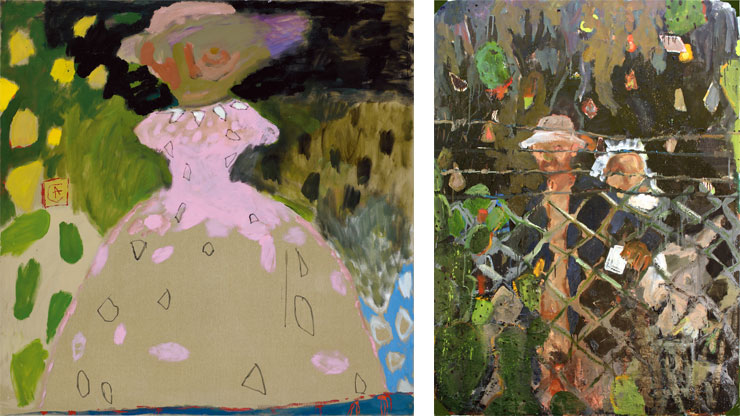
Chaim Nachman Bialik’s 1909 story “Behind the Fence” may contribute to an understanding of Cabessa’s work, and not just because of the prevalence of fences in his paintings. Bialik tells the story of the falling in love of Noah, a Jewish boy, and Marinka, a lovely gentile girl. Alienated from their respective traditional families and communities, the two protagonists fall in love by reaching through the physical and metaphorical fence that stands between them. Their mutual attraction – naïve, childish, pure, sensuous and frank – resonates in profuse descriptions of nature and animals. All of the above offers us a prism through which we may look at Cabessa’s search for a place that brings together nature and spirituality, tradition and culture. In his paintings, too, nature holds a significant place and resonates with an existential stance. In Cabessa’s works, the subject is aloof, observing from the sidelines, somewhat stammering, awkward and set apart, possibly held at bay by a society that does not take him into its fold or perhaps keeping himself at a safe distance from society lest he be engulfed by it.
Cabessa’s aspiration for a nonverbal, authentic, pre-linguistic, elaborate form of expression is manifested in his abstract paintings. He recounts that the stains in his paintings originate in an erased graffiti inscription he saw on a wall by the road. The graffiti – an eruptive, lashing-out, public form of expression – was silenced by the stronger scream of the erasure. But the rhythmically painted brushstrokes have paradoxically rendered the protest underneath them all the more powerful. There is some kind of ungainliness in Cabessa’s work which seeks the finest essence of things. It is a wish to shake off layers of culture, awareness, and knowledge as to what is good, proper, or beautiful painting; to strive for another kind of connection, somewhat like the whistle of the country boy in the well-known story after Sholem Asch, “The Country Tzadik.”
In Cabessa’s recent works, abstraction has become more and more dominant. Schematic, childish flowers, beautiful and wistful, are drawn with a free hand and sensuous palette while also trying to fit accepted modes of representation. Black and red triangles are painted with a thick brush directly onto the bare canvas, without a primer; raw, saturated stains whose rhythm resists the ornamental. These images rebel against simplistic binary expressions of east and west, local and international, male and female, cultured and wild, ancient and innovative, authentic and self-aware. Cabessa’s firstborn child, Yuval, is portrayed over and over again, standing by his side or held in his arms. Ever since her birth she has been central to his work, eliciting fears, wonder, and searches. A mysterious, hybrid figure recurs in the paintings and in the sculpture installed at the center of the gallery. It is Faymus, the ultimate alter-ego: feminine and masculine, Ben-Gurionesque, childish, archaic yet elaborate, an Infanta-like, demonic-headed figure wearing a Velázquezian lace dress; like folk-metal music. Cabessa’s artistic output extends between high and low, between paintings and objects, between fanzines and works on paper, between crudely patch-worked sculptures made of plaster and fabric, bronze pieces, and totemic wood carvings – yet another step in creating a total space that speaks his unique language.
Less Reading...
